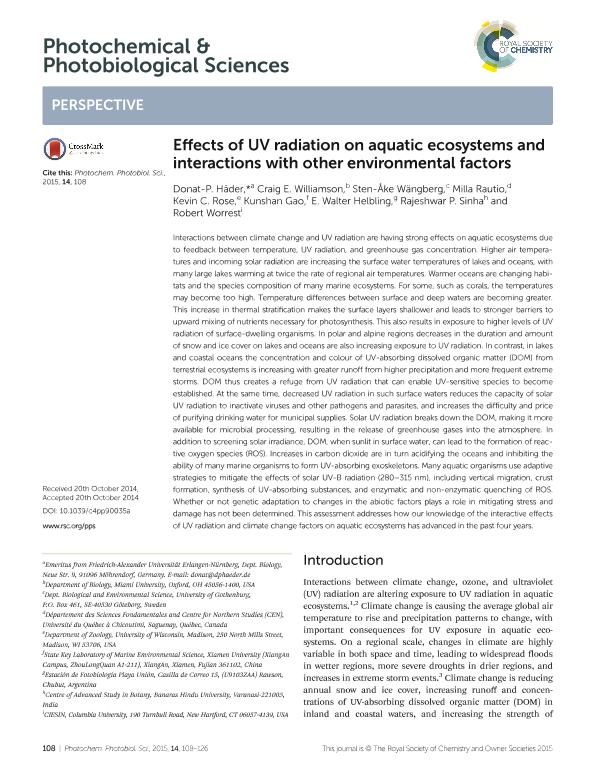Artículo
Effects of UV radiation on aquatic ecosystems and interactions with other environmental factors
Häder, Donat P.; Williamson, Craig E.; Wängberg, Sten Åke; Rautio, Milla; Rose, Kevin C.; Gao, Kunshan; Helbling, Eduardo Walter ; Sinha, Rajeshwar P.; Worrest, Robert
; Sinha, Rajeshwar P.; Worrest, Robert
 ; Sinha, Rajeshwar P.; Worrest, Robert
; Sinha, Rajeshwar P.; Worrest, Robert
Fecha de publicación:
01/2015
Editorial:
Royal Society of Chemistry
Revista:
Photochemical and Photobiological Sciences
ISSN:
1474-905X
Idioma:
Inglés
Tipo de recurso:
Artículo publicado
Clasificación temática:
Resumen
Interactions between climate change and UV radiation are having strong effects on aquatic ecosystems due to feedback between temperature, UV radiation, and greenhouse gas concentration. Higher air temperatures and incoming solar radiation are increasing the surface water temperatures of lakes and oceans, with many large lakes warming at twice the rate of regional air temperatures. Warmer oceans are changing habitats and the species composition of many marine ecosystems. For some, such as corals, the temperatures may become too high. Temperature differences between surface and deep waters are becoming greater. This increase in thermal stratification makes the surface layers shallower and leads to stronger barriers to upward mixing of nutrients necessary for photosynthesis. This also results in exposure to higher levels of UV radiation of surface-dwelling organisms. In polar and alpine regions decreases in the duration and amount of snow and ice cover on lakes and oceans are also increasing exposure to UV radiation. In contrast, in lakes and coastal oceans the concentration and colour of UV-absorbing dissolved organic matter (DOM) from terrestrial ecosystems is increasing with greater runoff from higher precipitation and more frequent extreme storms. DOM thus creates a refuge from UV radiation that can enable UV-sensitive species to become established. At the same time, decreased UV radiation in such surface waters reduces the capacity of solar UV radiation to inactivate viruses and other pathogens and parasites, and increases the difficulty and price of purifying drinking water for municipal supplies. Solar UV radiation breaks down the DOM, making it more available for microbial processing, resulting in the release of greenhouse gases into the atmosphere. In addition to screening solar irradiance, DOM, when sunlit in surface water, can lead to the formation of reactive oxygen species (ROS). Increases in carbon dioxide are in turn acidifying the oceans and inhibiting the ability of many marine organisms to form UV-absorbing exoskeletons. Many aquatic organisms use adaptive strategies to mitigate the effects of solar UV-B radiation (280–315 nm), including vertical migration, crust formation, synthesis of UV-absorbing substances, and enzymatic and non-enzymatic quenching of ROS. Whether or not genetic adaptation to changes in the abiotic factors plays a role in mitigating stress and damage has not been determined. This assessment addresses how our knowledge of the interactive effects of UV radiation and climate change factors on aquatic ecosystems has advanced in the past four years.
Palabras clave:
Uvr
,
Aqutic Ecosystems
Archivos asociados
Licencia
Identificadores
Colecciones
Articulos(CCT-CENPAT)
Articulos de CTRO.CIENTIFICO TECNOL.CONICET - CENPAT
Articulos de CTRO.CIENTIFICO TECNOL.CONICET - CENPAT
Citación
Häder, Donat P.; Williamson, Craig E.; Wängberg, Sten Åke; Rautio, Milla; Rose, Kevin C.; et al.; Effects of UV radiation on aquatic ecosystems and interactions with other environmental factors; Royal Society of Chemistry; Photochemical and Photobiological Sciences; 14; 1; 1-2015; 108-126
Compartir
Altmétricas



